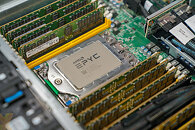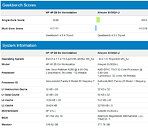Friday, January 8th 2021

AMD 32-Core EPYC "Milan" Zen 3 CPU Fights Dual Xeon 28-Core Processors
AMD is expected to announce its upcoming EPYC lineup of processors for server applications based on the new Zen 3 architecture. Codenamed "Milan", AMD is continuing the use of Italian cities as codenames for its processors. Being based on the new Zen 3 core, Milan is expected to bring big improvements over the existing EPYC "Rome" design. Bringing a refined 7 nm+ process, the new EPYC Milan CPUs are going to feature better frequencies, which are getting paired with high core counts. If you are wondering how Zen 3 would look like in server configuration, look no further because we have the upcoming AMD EPYC 7543 32-core processor benchmarked in Geekbench 4 benchmark.
The new EPYC 7543 CPU is a 32 core, 64 thread design with a base clock of 2.8 GHz, and a boost frequency of 3.7 GHz. The caches on this CPU are big, and there is a total of 2048 KB (32 times 32 KB for instruction cache and 32 times 32 KB for data cache) of L1 cache, 16 MB of L2 cache, and as much as 256 MB of L3. In the GB4 test, a single-core test produced 6065 points, while the multi-core run resulted in 111379 points. If you are wondering how that fairs against something like top-end Intel Xeon Platinum 8280 Cascade Lake 28-core CPU, the new EPYC Milan 7543 CPU is capable of fighting two of them at the same time. In a single-core test, the Intel Xeon configuration scores 5048 points, showing that the new Milan CPU has 20% higher single-core performance, while the multi-core score of the dual Xeon setup is 117171 points, which is 5% faster than AMD CPU. The reason for the higher multi-core score is the sheer number of cores that a dual-CPU configuration offers (32 cores vs 56 cores).
Sources:
Geekbench 4, via Leakbench, Hexus.net (image)
The new EPYC 7543 CPU is a 32 core, 64 thread design with a base clock of 2.8 GHz, and a boost frequency of 3.7 GHz. The caches on this CPU are big, and there is a total of 2048 KB (32 times 32 KB for instruction cache and 32 times 32 KB for data cache) of L1 cache, 16 MB of L2 cache, and as much as 256 MB of L3. In the GB4 test, a single-core test produced 6065 points, while the multi-core run resulted in 111379 points. If you are wondering how that fairs against something like top-end Intel Xeon Platinum 8280 Cascade Lake 28-core CPU, the new EPYC Milan 7543 CPU is capable of fighting two of them at the same time. In a single-core test, the Intel Xeon configuration scores 5048 points, showing that the new Milan CPU has 20% higher single-core performance, while the multi-core score of the dual Xeon setup is 117171 points, which is 5% faster than AMD CPU. The reason for the higher multi-core score is the sheer number of cores that a dual-CPU configuration offers (32 cores vs 56 cores).


41 Comments on AMD 32-Core EPYC "Milan" Zen 3 CPU Fights Dual Xeon 28-Core Processors
x86 is like oil companies, it WILL keep itself relevant somehow. Its too big to fail until all avenues to succeed are gone.
Xeon = 117171 / 2 = 58,585.5 points , Zen 3 = 111379 so
Plus, a glaring issue of single-socket vs dual-socket. I'm sure EPYC still wins, but that comparison is not just skewed, it's off the rails.Geekbench is the worst benchmark in existence. Their error margin is so huge, you can't even get stable results on the same machine back to back (especially GB4).
People that buy apple products love that wall garden and will stay in it. They were probably never going to buy a x86 product. Intel and Amd are clearly competitors Apple kinda competes with itself.
Place Tesla in the position of Apple and its a perfect fit, too. Tesla made electric simple and accessible, but still covers barely or less thsn 10% of the market, but still guides the other fossil based car builders forward, and makes it too big to ignore.
To stay on topic though: For me, I hate this comparison because of the huge difference in linux kernel versions. Multi-threaded scores on the Xeon setup with mitigations turned off is going to benefit a lot from all of the scheduling and power management changes in the Linux kernel over the last 5 years. This is why I say that this comparison is dumb.
Anyways on topic, with the ARM onslaught, we have only AMD to thank for fighting back that scourge!
56 Cores vs. 32 Cores, that is the Dual CPU system vs. Single CPU system!
For many-many years Intel and AMD are using Composite Theoretical Performance ( CTP ) values to evaluate Peak Processing Power of CPUs ( also known as Rpeak in Computer Science and HPC communities ):
CTP values ( Non-Normalized ) for Single CPU configurations:
Intel Xeon Platinum 8280 - 2.7 GHz / 28 cores / AVX-2 / FMA support - CTP = 2.419 TFLOPs ( ~15.6% slower than AMD EPYC 7543 Zen 3 )
AMD EPYC 7543 Zen 3 - 2.8 GHz / 32 cores / AVX-2 / FMA support - CTP = 2.867 TFLOPs
CTP values ( Normalized ) for Single CPU configurations:
Intel Xeon Platinum 8280 - 2.7 GHz / 32 cores / AVX-2 / FMA support - CTP = 2.765 TFLOPs ( ~3.6% slower than AMD EPYC 7543 Zen 3 ) ( 2.765 = 2.419 TFLOPs * 32/28 )
AMD EPYC 7543 Zen 3 - 2.8 GHz / 32 cores / AVX-2 / FMA support - CTP = 2.867 TFLOPs
Note: Intel's CPU number of Cores is multiplied by 32 / 28 ~= 1.1428571 to Normalize number of Cores to 32 and in that case we're comparing 32-Core Intel system vs. 32-Core AMD system
For Dual CPU configurations multiply TFLOPs numbers by 2.
As you can see Intel Xeon CPU is only 3.6% slower when compared to the latest Gen 3 AMD CPU if Normalization of number of Cores is taken into account.
PS: I'm a C/C++ Software Engineer and I'm Not in favour of Intel or AMD in that case. However, "Apples-must-be-compared-to-Apples" and Not to "Lemons"...